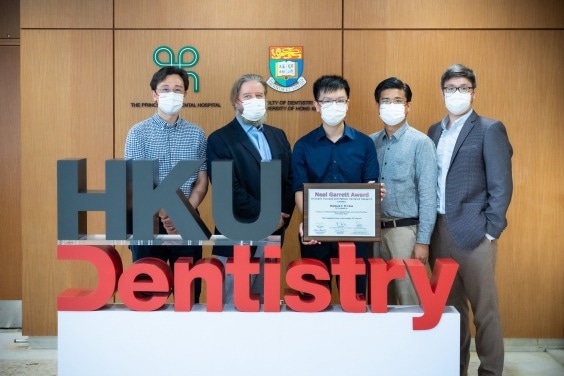Reviewed by Alex SmithJul 19 2022
Permanent tooth loss is a regular occurrence across the world, particularly among the elderly owing to age and generally worse oral health. It is often brought on by dental disorders or trauma.
 (From Right) Dr. Walter Lam, Dr. Khaing Myat Thu, Dr. Reinhard Chau, Professor Colman McGrath, and Dr. Richard Hsung. Image Credit: University of Hong Kong.
(From Right) Dr. Walter Lam, Dr. Khaing Myat Thu, Dr. Reinhard Chau, Professor Colman McGrath, and Dr. Richard Hsung. Image Credit: University of Hong Kong.
Failure to replace a lost tooth may have negative effects on facial appearance and chewing ability, as well as jawbone loss and tooth shifting, which can result in malocclusion and bite abnormalities and negatively influence the health of the remaining teeth, gum, jaw muscles, and jaw points.
Bridges and dentures are prosthetic appliances used to replace lost teeth. Artificial teeth are another name for them. In order for the patient to maintain their original look, chewing ability, and oral and physical health, the fake teeth must closely mimic the patient’s natural tooth.
The current computerized design method requires lengthy human input, the gathering of information on the teeth’s occlusion, and several denture fitting procedures due to the limited accuracy of promising technologies. As a result, designing and making dentures takes a long time.
In order to increase treatment effectiveness and improve patient experience, researchers from the Department of Computer Science at Chu Hai College of Higher Education and the Faculty of Dentistry at the University of Hong Kong (HKU) have developed a novel method using artificial intelligence to automate the design of customized dentures.
175 volunteers that were recruited at HKU were assessed using 3D Generative Adversarial Network (3D-GAN)-based AI technology. The research demonstrates that artificial intelligence (AI) technology might accurately automate the process of designing prosthetic teeth and rebuild the structure of a real, healthy tooth.
The 3D GAN algorithm was selected due to its superior performance on 3D object reconstruction compared to other AI algorithms. In the preliminary study, 3D GAN was able to rebuild similar shapes to the original teeth for 60% of the cases. It is expected to mature with more AI training data.
Dr. Reinhard Chau, Study Co-Investigator and Research Assistant, Restorative Dental Sciences and Applied Oral Sciences & Community Dental Care, Faculty of Dentistry, University of Hong Kong
The innovative method only requires a patient’s digital dentition model. It will then create a fake tooth that mimics a lost tooth by learning the characteristics of a person’s teeth from the rest of their dentition.
This will facilitate the treatment workflow for dentists in replacing a missing tooth, as the preparation and fitting process will require minimal time, and a patient will not need to stay at the clinic for long hours.
Dr. Walter Lam, Study Principal Investigator and Clinical Assistant Professor, Prosthodontics, Faculty of Dentistry, University of Hong Kong
The research is presented in the PLoS ONE publication. The study’s early findings were recently presented at the IADR General Session of the International Association of Dental Research. The paper was awarded the IADR Neal Garrett Clinical Research Prize and placed first in the senior category for the 2022 IADR-SEA Hatton Award.
Journal Reference:
Chau, R. C. W., et al. (2022) Artificial intelligence-designed single molar dental prostheses: A protocol of prospective experimental study. PLoS ONE. doi.org/10.1371/journal.pone.0268535.